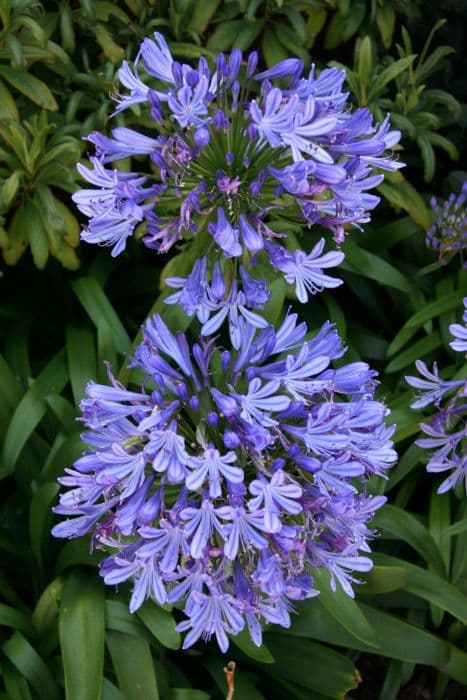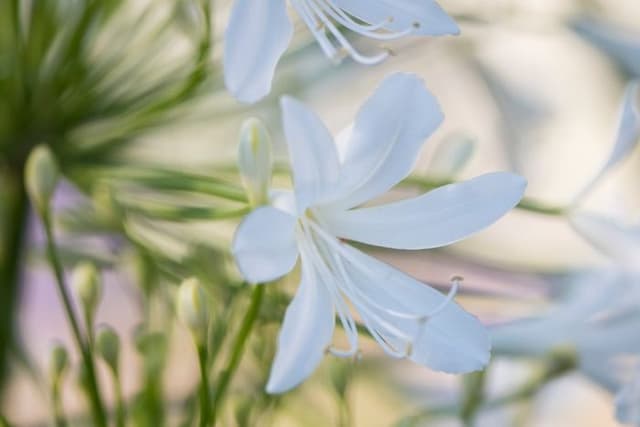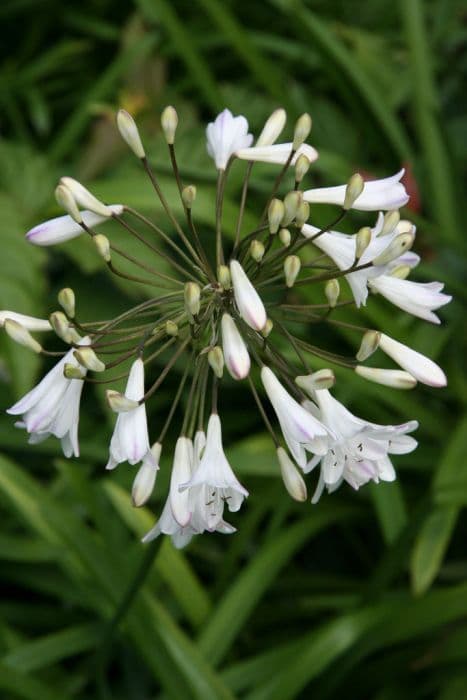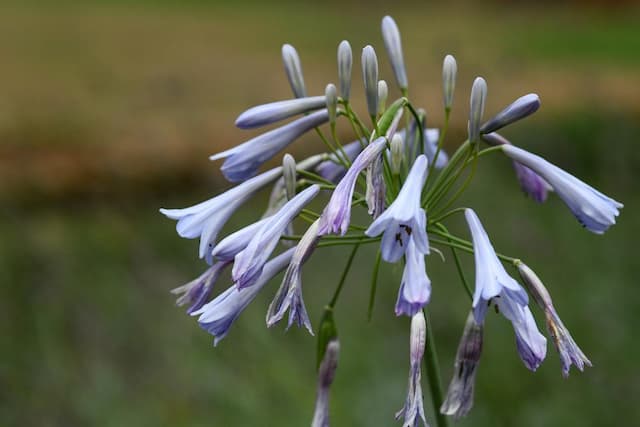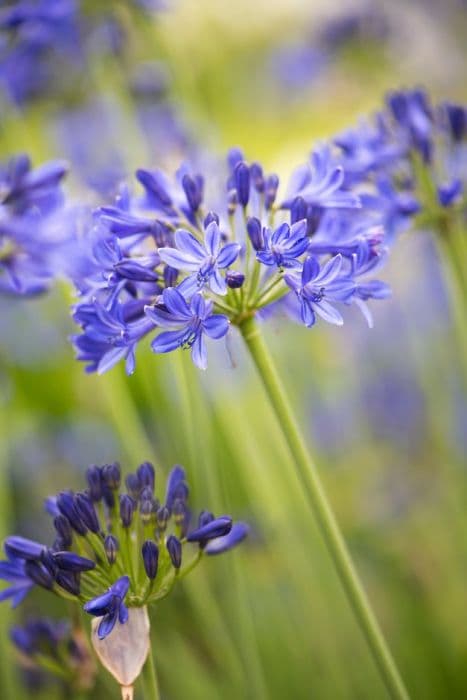African Lily Agapanthus 'Snow Cloud'

ABOUT
Agapanthus 'Snow Cloud' is a perennial plant with a lush, clumping habit characterized by its strappy, arching leaves that create a verdant and dense mound of foliage. The leaves are deep green, giving a rich backdrop to the striking floral display that emerges during its blooming season. The flowers themselves are what truly set this plant apart; they form at the ends of long, upright stems, where spherical clusters of individual blooms are presented in an almost globe-like inflorescence. Each small flower in the cluster is a pristine white, reminiscent of fluffy clouds in appearance, and they collectively create a snowball effect that is both elegant and eye-catching. The delicate, trumpet-shaped blossoms are known for their soft, yet vivid hue that provides a stunning contrast against the greenery beneath. The overall presentation of the Agapanthus 'Snow Cloud' is one of classic beauty, forming a spectacular focal point in gardens when it is in bloom. The plant exudes a lush and exotic charm that can add a touch of sophistication to any setting.
About this plant
 Names
NamesFamily
Amaryllidaceae
Synonyms
African Lily, Lily of the Nile, Love Flower
Common names
Agapanthus 'Snow Cloud'
 Toxicity
ToxicityTo humans
The Lily of the Nile, commonly referred to as Agapanthus, can be mildly toxic if ingested. The main components causing toxicity are saponins and glycosides, which can lead to gastrointestinal symptoms such as nausea, vomiting, and diarrhea. In some cases, it can also cause skin irritation when handled. It is advised to keep this plant out of reach of children and to wash hands after handling it to avoid potential reactions.
To pets
The Lily of the Nile, or Agapanthus, is also considered toxic to pets, including cats and dogs. If ingested, pets might experience symptoms such as vomiting, diarrhea, nausea, or abdominal pain. In addition, some animals may drool excessively or show signs of oral irritation. It is important to prevent pets from chewing on any part of the plant and to seek veterinary care if they do ingest any of it.
 Characteristics
CharacteristicsLife cycle
Perennials
Foliage type
Evergreen
Color of leaves
Green
Flower color
White
Height
2 feet [60 cm]
Spread
2 feet [60 cm]
Plant type
Bulb
Hardiness zones
8
Native area
South Africa
Benefits
 General Benefits
General Benefits- Ornamental appeal: The Agapanthus 'Snow Cloud', commonly known as Lily of the Nile, features attractive clusters of white flowers which can enhance the visual appeal of gardens and landscapes.
- Drought tolerance: Once established, the Lily of the Nile is quite drought-tolerant, making it suitable for water-wise gardens or areas with water restrictions.
- Low maintenance: This plant requires minimal care, with occasional fertilization and infrequent watering once mature, making it ideal for busy gardeners.
- Long blooming period: The Lily of the Nile typically enjoys a long flowering season, providing color and interest in the garden throughout summer into early autumn.
- Attracts pollinators: Its flowers attract bees and butterflies, which are beneficial for pollination of gardens and ecosystems.
- Container gardening: The plant can be grown in pots or containers, making it versatile for patios, balconies, and small spaces.
- Perennial growth: As a perennial, Agapanthus 'Snow Cloud' returns each year, replenishing your garden with its attractive foliage and flowers.
- Deer resistant: The plant is known to have some resistance to deer, which can help to reduce garden damage in areas where deer are a problem.
- Coastal suitability: Agapanthus 'Snow Cloud' is tolerant of salt spray and can be planted in coastal regions without fear of adverse effects from the salt-laden air.
- Erosion control: The root system of the Lily of the Nile helps to stabilize soil, making it a good choice for slopes and areas prone to erosion.
- Mass planting impact: When planted in large groups, the Lily of the Nile can create a dramatic display with its striking white blooms and lush foliage.
 Medical Properties
Medical PropertiesThis plant is not used for medical purposes.
 Air-purifying Qualities
Air-purifying QualitiesThis plant is not specifically known for air purifying qualities.
 Other Uses
Other Uses- African Lily can be used as a natural boundary marker or informal hedge because of its clumping growth habit and lush foliage.
- The leaves can be used in floral arrangements as green filler material to add texture and density to the design.
- The tall flower stalks may be dried and used in arts and crafts, such as in dried flower arrangements or as part of a natural wreath.
- The seed pods can be harvested and dried for ornamental purposes, adding an interesting element to both indoor and outdoor decorative displays.
- The robust root system of the African Lily can assist in reducing soil erosion on slopes or in areas prone to erosion due to its clumping growth.
- Dye can be extracted from the flowers or leaves to use in natural fabric dying processes, giving a soft to vibrant color depending on the concentration.
- The plant's dense habit can provide shelter and habitat for small garden wildlife like insects and amphibians.
- When used in a water garden or near a pond, the African Lily's foliage can provide a visually appealing transition from land to water.
- Photography subjects for both amateur and professional photographers can include African Lily's clusters of flowers and architectural leaves for their intricate details.
- The flowers can serve as an educational tool for botany or horticulture students learning about pollination and the structure of monocotyledon plants.
Interesting Facts
 Feng Shui
Feng ShuiAgapanthus, commonly known as Lily of the Nile, can be used in Feng Shui to introduce a smooth flow of chi due to its smooth, strappy leaves and calming white flowers which embody the metal element, beneficial for clarity and precision. It's especially good in areas where peaceful energy is needed, such as in a meditation space or the living area. Place them in the north for career growth or the east for family harmony.
 Zodiac Sign Compitability
Zodiac Sign CompitabilityThe plant Lily of the Nile is not used in astrology practice.
 Plant Symbolism
Plant Symbolism- Love Letters: The Agapanthus, commonly known as the Lily of the Nile or African Lily, is said to represent love letters or messages, possibly due to the clusters of flowers that can be reminiscent of multiple missives bound together.
- Beauty: With its striking and visually appealing flowers, the Agapanthus is often associated with beauty, reflecting its aesthetically pleasing appearance.
- Endurance and Survival: Native to South Africa, where conditions can be tough, the Agapanthus symbolizes endurance and survival against the odds.
- Purity: The 'Snow Cloud' variety, notable for its white flowers, embodies purity and innocence, similar to the way white is often used in various cultural contexts to signify these traits.
 Water
WaterFor Lily of the Nile, during the growing season, water the plant deeply once a week using approximately 1 gallon of water per plant, ensuring moisture reaches the root zone. During periods of drought or extreme heat, the frequency should be increased to twice a week, with the same amount of water per session. Reduce watering in the fall as the plant enters dormancy, and in winter, water just enough to prevent the soil from completely drying out.
 Light
LightLily of the Nile thrives in full sun to partial shade. The ideal spot would receive at least six hours of direct sunlight daily while offering some respite from the intense afternoon sun. Morning sunlight with partial afternoon shade is optimal for vibrant blooms and healthy growth.
 Temperature
TemperatureLily of the Nile prefers temperatures ranging from 50°F to 80°F, which are ideal for growth and flowering. The plant can survive temperatures as low as 20°F but may sustain cold damage, and it is best protected when temperatures drop below freezing. During summer, ensure that the plant is not exposed to prolonged temperatures above 90°F, which can lead to stress.
 Pruning
PruningPruning Lily of the Nile should occur in late winter or early spring before new growth starts. Remove any dead or damaged foliage and spent flower stalks to promote healthy new growth and improve air circulation. Typically, a thorough clean-up once a year is sufficient, but additional deadheading of flowers can be done as needed during the blooming season to encourage more blooms.
 Cleaning
CleaningAs needed
 Soil
SoilThe best soil mix for African Lily 'Snow Cloud' should be rich, well-draining, and loamy. A mixture of two parts loam, one part perlite or sand, and one part compost or well-aged manure will support its growth. This plant prefers a soil pH between 6.0 to 8.0, leaning towards slightly acidic to alkaline conditions.
 Repotting
RepottingAfrican Lily 'Snow Cloud' typically needs repotting every 2 to 3 years to refresh the soil and provide space for root growth. The best time to repot is in the spring just before the growing season begins.
 Humidity & Misting
Humidity & MistingAfrican Lily 'Snow Cloud' is tolerant of a wide range of humidity conditions and does well in average household humidity levels. It does not have specific humidity requirements, making it a versatile choice for gardeners.
 Suitable locations
Suitable locationsIndoor
Place in bright, indirect light and pot in well-draining soil.
Outdoor
Full sun to partial shade; protect from afternoon heat.
Hardiness zone
8-11 USDA
 Life cycle
Life cycleAgapanthus 'Snow Cloud', commonly known as the African Lily, begins its cycle with seed germination, which requires well-drained soil and can start either in a cold frame or directly in the garden when temperatures are suitable. After germination, the seedling phase involves the development of foliage and a root system, which can take several months to establish. Once the plant reaches vegetative maturity, it focuses on leaf growth and storing nutrients in its rhizomatous roots. As it enters the reproductive stage in early to mid-summer, it sends up tall flower stalks topped with umbels of white, trumpet-shaped flowers, attracting pollinators. After blooming, seed pods may form, and if left to dehisce, they can release seeds for dispersal; however, many gardeners propagate African Lily vegetatively via division of clumps in spring or fall to maintain desired plant traits. Finally, Agapanthus 'Snow Cloud' will go dormant in winter where hardy, dying back to the ground before re-emerging in spring, or it will require protection in colder zones where it's not winter-hardy.
 Propogation
PropogationPropogation time
Spring-Early Summer
The most popular method of propagating the Agapanthus 'Snow Cloud', commonly known as the African Lily, is via division. This process is best done in the late spring or early fall when the plant is not in active bloom. To propagate by division, carefully dig up the clump of the plant, ensuring a good portion of the root system is intact with each section. Using a sharp knife or spade, divide the clump into smaller sections, each with several shoots and a portion of the root ball. Replant these divisions promptly at the same soil depth they were previously growing, spacing them about 12 to 18 inches (approximately 30 to 45 centimeters) apart to allow for growth and adequate airflow. Water the newly planted divisions well to help establish them. Division not only helps to propagate African Lilies but also rejuvenates older clumps that may have become less vigorous over time.
